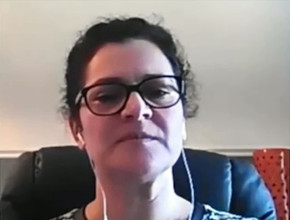Dr Harriette Van Spall, associate professor in the Division of Cardiology at McMaster University, scientist at the Population Health Research Institute, and cardiologist at Hamilton Health Sciences, connects with Dr Roman Jaeschke to put in context some of the most impactful heart failure clinical trials of recent years.
Roman Jaeschke, MD, MSc: Welcome to another edition of McMaster Perspective. In this episode we’ll try to put the heart failure treatment revolution together. The initial impulse was a paper published in The Lancet, which provided quite extraordinary results—on the basis of some modeling, mind you. Professor Van Spall is our expert in heart failure, both heart failure with reduced ejection fraction (HFrEF) and heart failure with maintained ejection fraction. Or rather preserved ejection fraction (HFpEF).
Harriette Van Spall, MD, MPH: That’s right.
Roman Jaeschke: It’s so difficult with all these abbreviations.
Harriette Van Spall: Hard to keep track of all this nomenclature, isn’t it?
Roman Jaeschke: It is. But we have no choice. We have to go with the modernization of time.
Professor Van Spall, please present the current heart failure revolution.
Harriette Van Spall: I love that you’ve given me a promotion, by the way. You’ve made me a professor from an associate professor. Thank you so much.
Roman Jaeschke: It’s coming. No questions about it.
Harriette Van Spall: I’ll accept it.
Heart failure has had exciting new therapies that have been tested in large clinical trials. We had the PARADIGM-HF (Prospective Comparison of ARNI with ACEI to Determine Impact on Global Mortality and Morbidity in Heart Failure) trial in 2014 that demonstrated the benefit of the angiotensin receptor–neprilysin inhibitor (ARNI) sacubitril/valsartan among patients with HFrEF. It was shown to improve the primary composite endpoint of cardiovascular death and heart failure hospitalization.
In 2019, the DAPA-HF (Dapagliflozin and Prevention of Adverse Outcomes in Heart Failure) trial demonstrated the efficacy of the sodium-glucose cotransporter 2 (SGLT-2) inhibitor dapagliflozin among patients with HFrEF. This drug improved the primary composite endpoint of cardiovascular death and heart failure hospitalization with a hazard ratio of 0.74, I believe.
These new therapies have been groundbreaking among our patients with HFrEF. Background therapy, historic therapy has consisted of beta-blockers, angiotensin-converting enzyme (ACE) inhibitors or angiotensin receptor blockers (ARBs), and mineralocorticoid-receptor antagonists (MRAs). A recent trial compared through indirect estimates the added value of MRAs, ARNIs, and SGLT-2 inhibitors versus the background therapy of beta-blockers and ACE inhibitors or ARBs. This analysis combined the 3 pivotal trials in HFrEF, which were the EMPHASIS-HF (Eplerenone in Mild Patients Hospitalization and Survival Study in Heart Failure), DAPA-HF, and PARADIGM-HF trials. It included individual patient data in the analysis. The primary endpoint for this indirect estimate of the added value of all of these classes was composite cardiovascular death or heart failure hospitalization. The assumptions were that the relative treatment effects were constant over time and that everyone derived equal benefit from the drug.
The projected incremental gains in event-free survival and overall survival were found to be quite remarkable. For the primary endpoint of cardiovascular death and heart failure hospitalization, treatment with the comprehensive disease-modifying therapies was estimated to afford 2.7 additional years for an 80-year-old person—typically a man, because a majority of these patients in the trials, about 80%, were men. For a 55-year-old patient, it added 8.3 additional years.
Roman Jaeschke: Years without the outcome.
Harriette Van Spall: This is for the endpoint of cardiovascular death or heart failure hospitalization.
For the all-cause survival, the incremental benefit was 1.4 additional years for an 80-year-old person and 6.3 additional years for a 55-year-old person. So [these were] remarkable benefits by adding MRAs, ARNIs, and SGLT-2 inhibitors to a beta-blocker regimen.
Roman Jaeschke: Remarkable if true, and truly remarkable; I’m talking about the prolongation of life by a number of years. Obviously it’s modeling, so we cannot be certain that it’s happening.
You mentioned the EMPHASIS-HF trial. We had 2 segments where you told us more about SGLT-2 inhibitors and ARNIs. We didn’t talk much about MRAs.
Harriette Van Spall: There was RALES (Randomized Aldactone Evaluation Study) that tested spironolactone in the setting of HFrEF. The EMPHASIS-HF trial tested the efficacy of eplerenone versus placebo among patients with HFrEF. There were just under 3000 patients in that clinical trial. Patients had an ejection fraction (EF) of less than 40%; I think the average EF was around 26%. They had primarily New York Heart Association (NYHA) class II symptoms, so these were not hospitalized patients. The primary outcome was cardiovascular death and heart failure hospitalization. The patients in the intervention group had a significant improvement in that endpoint in the EMPAHSIS-HF trial.
Roman Jaeschke: Any difference that we could consider between spironolactone and eplerenone?
Harriette Van Spall: We typically use spironolactone in our publicly funded health-care system for cost reasons. Patients who have gynecomastia often are switched to eplerenone. Many of us start eplerenone without first introducing spironolactone, but you’ll see spironolactone is probably the go-to agent for cost reasons. It’s on the hospital formularies across most jurisdictions.
Roman Jaeschke: MRAs on one hand were part of this novel package in the analysis, but on the other they are probably already more ingrained in the general practice. I presume if the background therapy here had included MRAs, the potential benefit probably would have been slightly lower. Is that correct?
Harriette Van Spall: Right. When MRAs were analyzed in the intervention group, so to speak, this comprehensive therapy group, the hazard ratio for the primary composite endpoint was 0.38, and that was the endpoint of cardiovascular death or heart failure hospitalization. But sensitivity analysis was performed using MRAs in the routine care group and the benefit was somewhat attenuated, with a hazard ratio of 0.64 when the MRA was combined with what was considered baseline therapy. And that makes sense. With MRAs used as baseline therapies, the disease-modifying agents—ARNIs and SGLT-2 inhibitors—yielded about 1.2 to 4.1 additional years of life and event-free survival.
Roman Jaeschke: In older and younger people, respectively.
Harriette Van Spall: That’s right.
Roman Jaeschke: Maybe the final question. If you are in your heart failure clinic and you have somebody with HFrEF who continues to not function as well as they would like to or as they could otherwise and they have symptoms, what do you think would be the optimal therapy these days?
Harriette Van Spall: I routinely use these newer agents in patients with HFrEF. There is a tremendous burden of disease, and hospitalizations for heart failure are still among the most common reasons for hospitalization in older adults.
Quality of life is important too. The DAPA-HF trial included quality of life and health status outcomes in analyses that were presented at our American Heart Association (AHA) meeting a few months ago. It showed that dapagliflozin in addition to these hard endpoints, if you will, that we all focus on improved the health status of patients who were on the agent. That’s an important patient-reported outcome measure that is worth treating patients for, particularly when we know that their survival is going to be prolonged and their heart failure hospitalizations are going to be reduced.
These agents, I should say, particularly SGLT-2 inhibitors, may also have a role in treating HFpEF; those trials are underway. Given their remarkable efficacy in a number of clinical settings among patients with cardiovascular disease or diabetes, I suspect that they might have efficacy for a broader range of indications, including HFpEF. But we’ll have to wait for clinical trials before we jump to any conclusions.
Roman Jaeschke: To summarize for single-minded internists, we are talking about beta-blockers, we are talking about MRAs, we are talking about the vasodilatory effect of ARNIs. [Or of ACE inhibitors and ARBs] if you don’t have or cannot afford ARNIs. And it sounds like the new kid on the block is SGLT-2 inhibitors.
Harriette Van Spall: That’s right. That describes the regimen that reduces death and in most of the trials also heart failure hospitalization.
I will say there’s a newer kid on the block, vericiguat. This was a soluble guanylate cyclase stimulator that was tested in the VICTORIA (Vericiguat Global Study in Subjects with Heart Failure with Reduced Ejection Fraction) trial recently in patients with HFrEF and was found to improve the primary outcome of cardiovascular death or heart failure hospitalization, with a hazard ratio of 0.90 driven primarily by a reduction in heart failure hospitalizations. There are nuances to this, as it’s probably more effective in patients who are sicker than those in the DAPA-HF trial. It has not yet been approved in any country, so it’s still at the horizon.
Roman Jaeschke: It looks like it’s not in its prime time yet. What I want to remind you is that—I haven’t looked there, maybe you’ve done it already—we probably need to update the McMaster Textbook heart failure chapters to include SGLT-2 inhibitors.
In the meantime, thank you very much for this fascinating journey. I really appreciate it. I learned a lot, and I hope our listeners did as well. Thank you.
Harriette Van Spall: Thank you so much for having me, Roman. It was such a great excuse to see you.
Roman Jaeschke: Thank you. Goodbye.
 English
English
 Español
Español
 українська
українська











